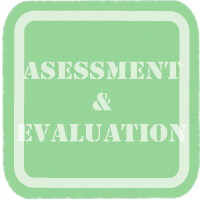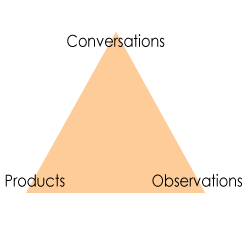 Triangulation in Assessment
Triangulation in Assessment
 Whether conducting assessment FOR learning or assessment OF learning, a teacher must have sufficient proof of a students’ learning. By using a process known as triangulation, teachers can obtain data of student learning from three different sources, thereby ensuring sufficient data is collected in order to evaluate student learning. By collecting data from multiple sources, teachers are able to verify the data they collect against each other thus allowing them to gain an accurate portrayal of student progress.
Whether conducting assessment FOR learning or assessment OF learning, a teacher must have sufficient proof of a students’ learning. By using a process known as triangulation, teachers can obtain data of student learning from three different sources, thereby ensuring sufficient data is collected in order to evaluate student learning. By collecting data from multiple sources, teachers are able to verify the data they collect against each other thus allowing them to gain an accurate portrayal of student progress.
What is triangulation?

Triangulation is a process by which a teacher collects evidence about student learning; this evidence is collected from three different sources. These sources are conversations, observations, and products.
Conversation is used to talk with students in a less formal, less structured way; these conversations can take place as students enter the classroom, in the halls of the school between classes, etc. For example, a teacher may ask a student what they did on the weekend, how well their basketball team is playing, if they saw a good movie recently, etc. By conversing with students in this way, the teacher can get a better picture about the students’ language abilities.
Observations take place during class time, while students are involved in individual, pair or group work. The teacher will circulate around the room and observe student learning. Observations can be documented using a check list (which outlines specifically what the teacher is looking for on that particular day) or anecdotal notes (the teacher simply makes written comments about what a student is doing, how they are working, which concepts the student has grasped, which concepts the student still struggles with, etc.). In order to make this process worthwhile, the teacher may choose to only observe a small number of students in one class period; this way the teacher can observe the selected students for longer periods of time, during different activities, working with different concepts. The observation process is completed after the class has ended with the teacher taking the checklist results or anecdotal notes and putting them into a file for each student. This process allows the teacher to track each student’s progress over time in a much more effective and accurate manner.
Finally, products refer to the tangible materials, such as tests, tasks or projects, used to assess student learning. These products are used to demonstrate what the student is capable of doing after going through the learning process.
back to top
How does triangulation help to assess students effectively in the language classroom?
 |
Watch the video to see how this teacher uses triangulation in her classroom. In your opinion, what are the possible benefits AND challenges of using triangulation? (time 1:13) |
Triangulation is effective and accurate for determining student performance because it can show a teacher at what level a student most consistently performs. In addition, if the teacher sees that a student struggles in one area but does significantly better in the other two areas, that teacher can work more effectively with that student to bring their overall performance to a more consistent level.
What role do the learners play when using triangulation?
Learners should play an active role throughout all stages of assessment in order for them to feel as if they have ownership of their work and in order to hear feedback about how they are doing. In all parts of triangulation the learner can be involved. In addition to taking part in conversations with the teacher, learners should also be involved in discussions or interviews about final products and about data collected from observations. By giving the learner a role in the assessment process the goal is to encourage students to invest in their own learning thus increasing student motivation. Teachers can also involve students in assessment by using student self-assessments.









